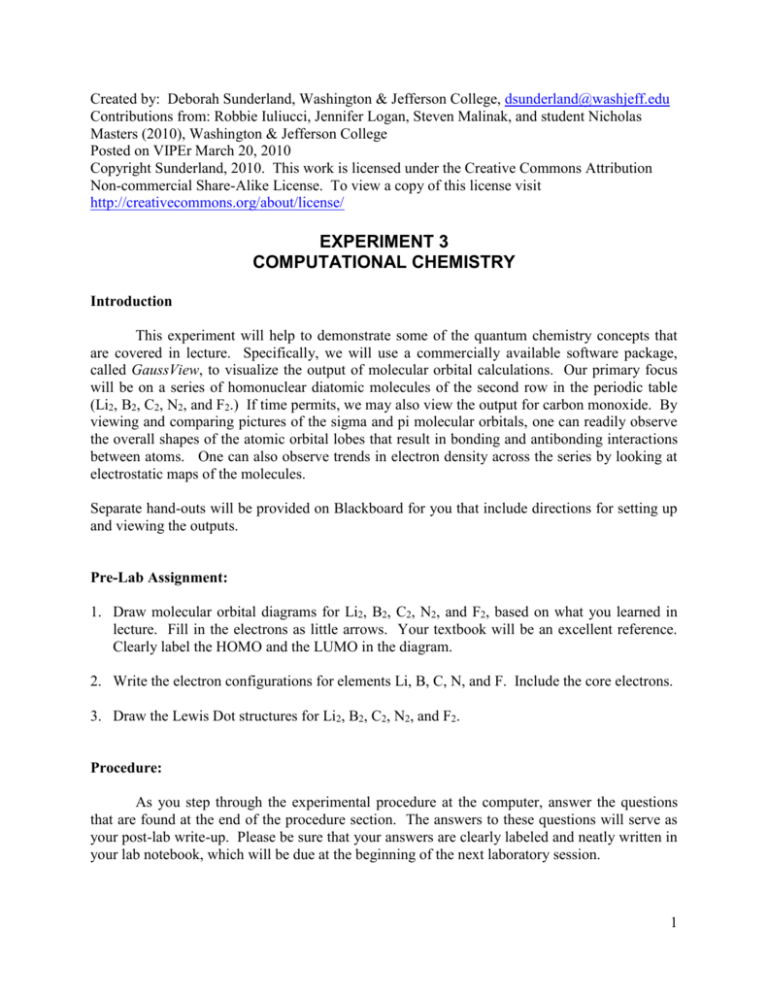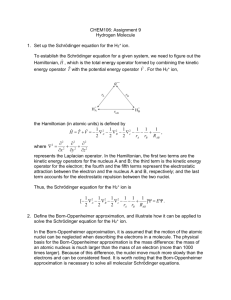MO Lab Experimental Instructions
advertisement

Created by: Deborah Sunderland, Washington & Jefferson College, dsunderland@washjeff.edu Contributions from: Robbie Iuliucci, Jennifer Logan, Steven Malinak, and student Nicholas Masters (2010), Washington & Jefferson College Posted on VIPEr March 20, 2010 Copyright Sunderland, 2010. This work is licensed under the Creative Commons Attribution Non-commercial Share-Alike License. To view a copy of this license visit http://creativecommons.org/about/license/ EXPERIMENT 3 COMPUTATIONAL CHEMISTRY Introduction This experiment will help to demonstrate some of the quantum chemistry concepts that are covered in lecture. Specifically, we will use a commercially available software package, called GaussView, to visualize the output of molecular orbital calculations. Our primary focus will be on a series of homonuclear diatomic molecules of the second row in the periodic table (Li2, B2, C2, N2, and F2.) If time permits, we may also view the output for carbon monoxide. By viewing and comparing pictures of the sigma and pi molecular orbitals, one can readily observe the overall shapes of the atomic orbital lobes that result in bonding and antibonding interactions between atoms. One can also observe trends in electron density across the series by looking at electrostatic maps of the molecules. Separate hand-outs will be provided on Blackboard for you that include directions for setting up and viewing the outputs. Pre-Lab Assignment: 1. Draw molecular orbital diagrams for Li2, B2, C2, N2, and F2, based on what you learned in lecture. Fill in the electrons as little arrows. Your textbook will be an excellent reference. Clearly label the HOMO and the LUMO in the diagram. 2. Write the electron configurations for elements Li, B, C, N, and F. Include the core electrons. 3. Draw the Lewis Dot structures for Li2, B2, C2, N2, and F2. Procedure: As you step through the experimental procedure at the computer, answer the questions that are found at the end of the procedure section. The answers to these questions will serve as your post-lab write-up. Please be sure that your answers are clearly labeled and neatly written in your lab notebook, which will be due at the beginning of the next laboratory session. 1 Questions to Answer: 1. Sketch pictures of a 2s atomic orbital and 2px, 2py, and 2pz atomic orbitals. Your textbook uses the x axis as the internuclear axis; however, when studying molecules, it is actually more conventional to use the z axis as the internuclear axis. GaussView follows this convention. You can use the following Cartesian axes as a reference in your sketches. Be sure to distinguish between a positive or negative sign of the wavefunction (i.e. you may want to shade the negative lobe for the p orbitals.) X Z Y 2. Sketch the first and third MO for Li2. Be sure to distinguish between signs of the wavefunctions. Are these sigma or pi orbitals? Are they bonding or antibonding? Which sigma MO, if any, plays a bigger role in the bond between Li atoms? In other words, can you tell which one is the HOMO and why it plays a bigger role in the bonding? 3. Sketch the antibonding sigma MO observed for Li2. Briefly describe the significance of the different shape when compared to the bonding sigma MOs. 4. Sketch the fifth and sixth MO for B2. These MOs should be a degenerate pair. Are they sigma or pi MOs? Are they bonding or antibonding? Using your knowledge of the total number of electrons in B2, predict whether B2 is paramagnetic or diamagnetic, based on the MO calculations and how electrons fill the orbitals. 5. C2 has 12 total electrons. In addition to 4 filled sigma MOs, there are 2 degenerate bonding pi MOs that are filled. Sketch these bonding pi MOs observed from the output. Can you tell which atomic orbitals are the primary contributors to these bonding pi MOs? (in other words think about how the orbitals are shaped and how they are oriented in space and choose from the 2s, 2px, 2py, and/or 2pz AOs.) 6. Sketch the sigma 2pz MO from the output for C2. This MO represents the LUMO. Is it bonding or antibonding? 7. For N2, the sigma 2pz molecular orbital, that was unfilled for C2, is now filled. Which frontier MO does this now represent? “Frontier Orbitals” are the ones that collectively describe the HOMO and the LUMO, as they lie at the occupied-unoccupied frontier. Sketch 2 this MO. Is there any significant difference in shape between the N2 sigma 2pz MO and the one for C2? What bond order is expected for N2, based on molecular orbital calculations? 8. Look at the potentiostatic pictures for the series Li2, C2, and N2. Include sketches, and thoroughly comment on the differences you observe. As bond orders change in the series, can you see any differences in bond lengths? If no differences are actually observed in your outputs, what do you expect to happen to bond lengths for the elements in this series. Post-Lab Analysis: The answers to the lab questions will serve as your post-lab write-up. Please be sure that your answers are clearly labeled and neatly written in your lab notebook, which will be due at the beginning of the next laboratory session. 3








